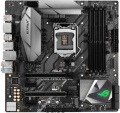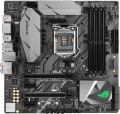Add to comparison |  |  |
|---|---|---|
| Asus ROG STRIX Z370-G GAMING (WI-FI AC) | Asus ROG STRIX Z370-G GAMING | |
| Outdated Product | from $269.81 | |
| TOP sellers | ||
One M.2 connector is vertical. | One M.2 connector is vertical. | |
| Features | gaming for overclocking | gaming for overclocking |
| Socket | Intel LGA 1151 v2 | Intel LGA 1151 v2 |
| Form factor | micro-ATX | micro-ATX |
| Power phases | 10 | 10 |
| VRM heatsink | ||
| LED lighting | ||
| Lighting sync | Asus Aura Sync | Asus Aura Sync |
| Size (HxW) | 244x244 mm | 244x244 mm |
Chipset | ||
| Chipset | Intel Z370 | Intel Z370 |
| BIOS | Ami | Ami |
| UEFI BIOS | ||
RAM | ||
| DDR4 | 4 slot(s) | 4 slot(s) |
| Memory module | DIMM | DIMM |
| Operation mode | 2 channel | 2 channel |
| Max. clock frequency | 4000 MHz | 4000 MHz |
| Max. memory | 64 GB | 64 GB |
| XMP | ||
Drive interface | ||
| SATA 3 (6Gbps) | 6 | 6 |
| M.2 connector | 2 | 2 |
| M.2 | 1xSATA/PCI-E 4x, 1xPCI-E 4x | 1xSATA/PCI-E 4x, 1xPCI-E 4x |
| Integrated RAID controller | ||
Expansion slots | ||
| 1x PCI-E slots | 2 | 2 |
| PCI-E 16x slots | 2 | 2 |
| PCI Modes | 16x/0x, 8x/8x | 16x/0x, 8x/8x |
| PCI Express | 3.0 | 3.0 |
| CrossFire (AMD) | ||
| SLI (NVIDIA) | ||
| Steel PCI-E connectors | ||
Internal connections | ||
| USB 2.0 | 2 | 2 |
| USB 3.2 gen1 | 1 | 1 |
Video outputs | ||
| HDMI output | ||
| DisplayPort | ||
Integrated audio | ||
| Audiochip | SupremeFX | SupremeFX |
| Sound (channels) | 7.1 | 7.1 |
| Optical S/P-DIF | ||
Network interfaces | ||
| Wi-Fi | Wi-Fi 5 (802.11aс) | |
| LAN (RJ-45) | 1 Gbps | 1 Gbps |
| LAN ports | 1 | 1 |
| LAN controller | Intel I219V | Intel I219V |
External connections | ||
| USB 2.0 | 2 | 2 |
| USB 3.2 gen1 | 4 | 4 |
| USB 3.2 gen2 | 2 | 2 |
| PS/2 | 1 | 1 |
Power connectors | ||
| Main power socket | 24 pin | 24 pin |
| CPU power | 8 pin | 8 pin |
| Fan power connectors | 4 | 4 |
| Added to E-Catalog | october 2017 | october 2017 |